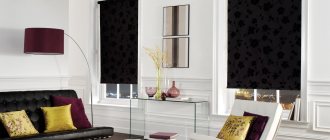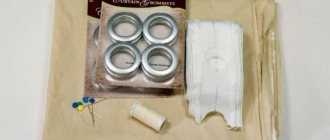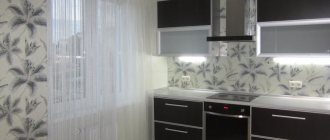Taking measurements
It is inconvenient to use a tailor's meter when measuring; it is better to take a hard metal tape measure.
To calculate the width of curtains, take as a basis:
- suspension length;
- fabric fluffiness factor (this is a separate topic for discussion);
- allowances for edge processing.
The main parameter is width
When choosing a curtain or cornice, you need to remember the golden rule: the curtain hanger should be up to 50 cm longer than the width of the window.
When open, the curtains should not interfere with the penetration of sunlight; the window opens completely. In narrow rooms, the wall is draped across its entire width - visually the space expands.
When measuring a hanger, measure its working distance - the width of the rail, string or rod along which the curtain will move. This is the main parameter when calculating the amount of fabric for curtains.
Calculation example
When all the necessary measurements have been taken, it is time to calculate the width and length of the curtains or fabric for them. If the resulting width of the window area is 2 m and the length is 2.7 m, and you need to purchase curtains and drapes, then you can safely use the assembly factor (KS) = 2 and then we find that the width should be 4 m for a given length.
If you want the window to be decorated with original and unique curtains that are not available in the store, then you need to buy the required amount of fabric to sew them . So, how much fabric will be needed for curtains and drapes for our conditional window?
The standard width of a roll of translucent tulle is 2.8 m , which should be quite enough for the standard window height, so the length issue remains resolved. As for the width, given the width of the window and the selected frame, you will need 2 * 2 = 4 m of fabric. But since the allowances on the sides are 5 cm, the total amount of fabric will be 4.1 m.
The width of curtain fabric is usually 1.4, 2.8 or 3.0 meters. It’s good if the width of the canvas ideally matches the length of the window opening, but it may be that the width is not enough, and then you will have to measure the fabric lengthwise and use several canvases to cover the window opening. Here it is important not to forget about the combination of the pattern and the length of the repeat - a repeating element of the ornament. In this case, you can sew a special fabric together, or maybe just make curtains from two parts.
The calculation in this case will be like this:
amount of fabric = ((window opening height + allowance)*number of panels) + repeat * (number of panels – 1)
If the window width is 2 m and KS = 2, and the width of the fabric in the roll is 1.4 m, then to make curtains, for example, you will need 3 canvases: 1.4 * 3 = 4.2 m, with a repeat value of 0.35 m we get the following data:
amount of fabric = ((2.7+0.2)*3)+0.35*2=9.4 m
If after cutting the fabric and sewing the curtains there is a lot of fabric left , and this may be when a large pattern was chosen, then from the remnants it will be possible to sew tiebacks for curtains or small pillows for the sofa. When the curtains and other textiles in the room are made in the same style, this gives a special effect to the room.
It’s easy to sew the most common curtain models yourself, but if you doubt your professionalism or are planning to decorate a window with an elaborate model, then it is better to resort to the services of specialists.
Pomp factor
Curtains never hang perfectly evenly on a window; there should always be gathers or folds. Drapery is a standard design technique.
The number and depth of folds depend on the texture of the fabric and its weight. Generally accepted coefficients of pomp depending on the height of the ceilings.
How to calculate folds on curtains:
- the texture of organza allows you to make numerous folds, fabric consumption increases from 2 to 4 times (if there is a lot of pomp, you can limit yourself to one organza and not make curtains);
- tulle is purchased in 1.5–3 widths (the more airy the fabric, the greater the fluffiness factor can be provided);
- veils - from 1.5 to 2.5;
- silk – from 1.2 to 3;
- linen - from 1.5 to 4 (when attached to eyelets);
- mixed fabrics - from 1.5 to 3.5;
- velvet, jacquard, thick curtains - from 1.2 to 2.5.
Fabrics with large patterns or large floral prints should be completely straightened across the window to avoid tackiness. For them, folds and gathers are unacceptable. The type of assemblies depends on the type of fastening.
The highest coefficient of pomp is found in pencil folds and puffs. A little lower - near the curtain tape and eyelets. If the curtain hangs on hinges, it is not gathered much.
Choosing the length and width of curtains depending on the type of room
Now I will present short recommendations for choosing the size of curtains depending on the type of room where we will use them
Choosing the size of curtains for the kitchen
Length and width of curtains in the kitchen. Since there are many sources of pollution in the kitchen - grease, steam and other delights, for easier care of curtains it is preferable to have curtains with a small area of contamination. Curtains up to the length of the window sill and with a minimum number of folds in width are suitable for this criterion, optimally - smooth, read in width equal to the length of the cornice. Of course, if you are not afraid of more frequent washing of curtains, then you can choose long and more draped options.
Choosing the size of curtains for the living room
- Curtains for the living room in length . Classic floor-length curtains will look good in the living room. That is, the length of the curtains is equal to the distance from the cornice to the floor, plus or minus the fastening of the curtains.
- Curtains in the living room in width . The width depends on the size of the room and the style of the interior. If the living room is in classical styles, then draping the curtains is acceptable, which means the width of the curtains can be calculated according to the table given above. If the interior is in a modern style, for example, the interior is in a minimalist style, then the width of the curtains should be equal to the length of the cornice - that is, smooth and without folds.
How to choose curtain sizes for the bedroom
Curtains in the bedroom are preferable with a voluminous texture that immerses you in peace.
- Bedroom curtain length . Elongated curtains with a length of 20-30 centimeters longer than the distance from the cornice to the floor are well suited.
- The width of the curtains in the bedroom should provide maximum folds, i.e. at least 2.5 times the length of the cornice.
How to choose curtain sizes for children's rooms
Curtains in a nursery should be easy to wash and not have extra areas for contamination. Active kids play everywhere, including near the windows.
- Length of curtains for children's . The optimal length would be to the floor without unnecessary overlap. that is, the distance from the cornice to the floor.
- The width of the curtains in the nursery can be the same as in the living room without unnecessary folds, but you can also make more draped options, i.e. The width of the curtain is from 1.5 to 2.5 times the length of the cornice.
Of course, all the recommendations mentioned above are of a general nature, but I hope that a hundred of them were enough to immerse you in the topic. And now you can independently choose the size of curtains in your home.
How much to leave on the edges
For edge processing, up to 3 cm is usually left on both sides. When the edge is stitched, the curtain looks finished.
Raw edges on thick curtain fabrics are allowed. During factory production, the edges of the canvas are made rigid. Sometimes it is enough to remove single threads, and the edge of the curtain is ready.
Curtains for the bedroom - 135 photos of the best new products and exclusive designs. Review of unusual design options and combinations of curtains in the bedroom interiorCurtains for suspended ceilings - features of design and selection of curtains for interiors (135 photos)
- How to decorate curtains - useful tips and options for the best decoration ideas on 115 new photos!
Deciding on the length
When decorating interiors, a variety of curtain lengths are acceptable. In children's rooms and kitchens, curtains up to the window sill or 10-15 cm lower are acceptable.
Long ones are appropriate in living rooms and bedrooms. They can lie on the floor, be 1.5-2 cm higher. Much depends on the taste of the owners and the overall design solution.
The type of fastening must also be taken into account:
- if the curtain hangs on loops, the length is measured from their beginning;
- the curtain tape is attached at any height; if desired, you can cover the cornice with a curtain - the extreme point of measurement is selected independently;
- when attaching curtains to eyelets, the length is calculated from the outer edge of the rod with a margin of 2 cm (this is the minimum distance from the edge to the eyelet).
To decorate the bottom edge, you need to leave 5 to 8 cm. On light fabrics, a weight cord is inserted into the edge.
It is necessary to provide for the “shrinkage” of the fabric after washing. Linen, curtains based on natural fabrics are reduced in length by up to 10%.
If the ceiling height is 2.5 meters, add 2.5 cm. If the ceilings are high, you need to add up to 5 cm. Knowing all these basic rules, you can independently calculate the footage of the curtains.
Austrian curtains - the best models with interesting tailoring options in the interior + 150 photos- Sheer curtains are an option that will help keep the interior light and cozy +140 photos
Art curtains - 125 photos of modern curtains with exceptional interior design!
Determining the length of the curtain
The distance from the bottom edge of the curtain to the floor is not necessarily the classic 2 cm: depending on the nature of the room, its interior, as well as the taste of the owners, the length varies greatly. But since you’ve already chosen the width, it’s time to figure out how to choose the length of the curtains?
Designers, according to НowBuySellRu, recommend proceeding from the purpose of the room. Curtains in the bedroom should not reach the floor by 3-4 cm, and curtains should completely cover them. If you want to hang curtains on the floor, add 20-30 cm to the total length to create a beautiful vertical wave. In the children's room and kitchen, it would be wiser to hang selected curtains with a length just below the window sill.
If you decide to sew the curtains yourself and take all the measurements, do not forget to add 5 cm to the length for hemming and processing of the material.
Another important nuance, according to Haubeysell, is the drawing. Models consisting of two parts must perfectly match in ornamentation. When measuring the length, we measure the repeating element and take the result into account in the cutting.
We buy fabric
Knowing the required length and width of the curtains, you need to buy the right amount of fabric. Standard web width in rolls:
- light fabrics (tulle, veil, organza) – 2 m 80 cm;
- curtains - from 1 m 40 cm to 3 m.
How to correctly calculate curtains if the width of the fabric is not a multiple of the width of the curtains? If you need three lengths, you can make three separate curtains.
If asymmetry is inappropriate, the curtains must be sewn. It is better to do this with a linen seam. For this, it is necessary to provide an additional 3 cm for each curtain.
To calculate the total amount of fabric, simply multiply the height of the curtain, taking into account all allowances, by the number of segments.
It is more difficult to purchase fabric with a large pattern or a floral print that is now fashionable.
It is necessary to measure the height of the report. It should be repeated on the curtains an equal number of times. When purchasing fabric for curtains, it is measured only from the beginning of the print or pattern.
You may have to overpay, but the curtains will look organic. Large designs will require more fabric than small floral prints or plain drapes.
What is curtain tape
Curtain tape is a longitudinal braid that acts as a frame for draping curtains. Inside the tape, in special pockets, there are cords, the tension adjustment of which allows you to form decorative folds in the upper part of the curtains.
The technology of curtain draping is quite complex; without proper experience, it is almost impossible to give the fabric the desired appearance. Curtain tape greatly simplifies this process - when using it, you can create folds of any density and shape; moreover, any needlewoman can calculate and sew the tape to the fabric without any problems.
All braids on the market can be divided into the following groups:
- Opaque - intended for dense curtain fabrics, and transparent - used for decorating tulle and curtains made of light materials such as organza and polyester;
- Narrow - width from 2.5 to 5 centimeters, and wide - from 6 to 15 centimeters;
- Sew-on - attached to the fabric using a sewing machine, and braids glued with a hot iron;
- Depending on the method of fixation on the cornice, there are tapes with Velcro or loops.
The braids also differ in the number of gathering cords and compartments with hooks, the configuration of which determines the appearance of the formed folds.
The most popular are ribbons that create the following forms of drapery:
- Vertical pencil folds;
- Puffed diamond-shaped folds;
- Fan (French) folds;
- Bell folds.
Bell pleats
Pencil pleats can be assembled using the simplest tape with two cords without fixing hooks. All draperies of complex shape belong to the shaped category; for their formation, braids with a rather complex design are used, in which there are limiting hooks that prevent the fabric from straightening.
conclusions
When making curtains yourself, it is important to take into account all allowances. They can range from 8 to 40 cm (with eyelet fastenings).
Chintz shrinks the most, and linen shrinks a little less. Synthetic curtains retain their shape for a long time, but are more likely to fade.
Silk becomes brittle when exposed to the sun and crumbles over time. When choosing short curtains for the kitchen or nursery, it is better to buy fabric with a margin in order to create a thick bottom edge.
It can be glued with thermal tape or a weight cord inserted. Taking these nuances into account, you can make chic curtains yourself that will delight you for a long time.
Photo tips on how to calculate curtains
Read here Thread curtains - the most suitable interior options with thread curtains in 105 photos!
Did you like the article? Share 











